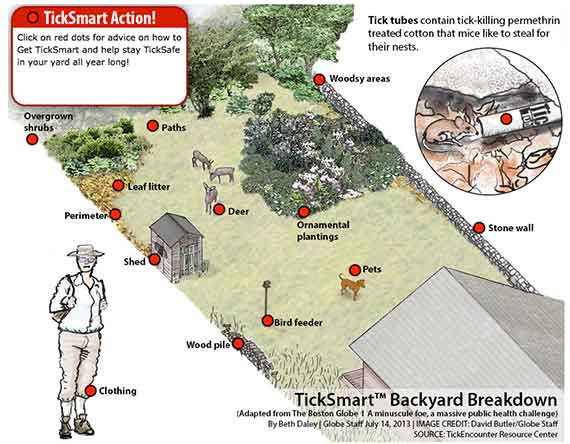Ahh, SPRING. Days growing longer with winter’s snow and ice receding. Those hungry ticks can barely wait for warmer temps!! In fact, tick activity is already ON in the South, West and even the Mountain regions of America.
Here are our favorite SPRINGTIME TICKSMART ACTIONS – do them now (or at least soon) to stay TickSafe.
Backyard tick control
Backyard tick control can be very effective when using proven-effective tick killers applied to match the biology of the type of tick present. If you’ve never done backyard tick control before, then you’ll probably want to schedule the first treatment as soon as the snow is gone and the ground is unfrozen. Last fall’s leftover adult blacklegged ticks, along with newly emerging adult American dog ticks and Lone Star ticks will only increase in activity from March to May. In our experience, high pressure sprays of Bifenthrin on the perimeter and into the shrubby border work exceptionally well for blacklegged tickcontrol, but the other 2 types of ticks may venture out a bit further into the yard. If you commonly experience more Lone Star ticks than blacklegged ticks, consider combining a perimeter spray treatment with an application of Bifenthrin granules applied out into the yard several feet. If there are paths or walkways in and around your property, be sure to treat all of the areas that your regularly (and even occasionally) use.
Nymphal blacklegged ticks wait to become active until mid-May in the mid-Atlantic, northeast, and upper mid-west regions but become active a bit earlier further south. For best protection against these dangerous ticks, plan to schedule one or two additional perimeter spray treatments in mid-May and mid-June.
Eliminate tick habitat

As part of your spring yard clean-up, eliminate tick habitat by raking and removing leaves that may have blown into yard edges and under shady vegetation. However, be sure to wear tick repellent in your clothes (see below) for those and other outdoor Spring activities, and follow up with daily

tick checksAFTER you’ve taken your outdoor clothes off. For untreated clothes, running them through a hot dryer for 10 minutes should kill any loose and wandering ticks that may have hitched a ride inside.
Tick control on pets
If you stopped your pet’s tick preventive over the winter, get it started again NOW. Outdoor dogs and cats will likely be the first family members to find a tick. There are

three basic types of products; be sure to use the product that best matches your goals:
- Products that kill ticks pretty much on contact before they attach and start feeding (quick tick knockdown).
- Products that kill after ticks have attached and started to feed (ticks bite to die).
- Products that may kill fleas and other parasites but don’t really kill ticks effectively (read the label).
Tick repellent clothes
Wearing tick repellent clothes is an easy, safe and effective way to prevent ticks from biting. Adult stage ticks are usually waiting on tall grass or shrubs a foot or two above ground, so wearing tick repellent pants and tucking in your shirt can be an effective springtime TickSafe wardrobe. The most cost-effective way to do this is to either purchase already treated pants or have your own favorite outdoor clothes treated commercially. In late spring and summer when the nymphs emerge, we also recommend spraying your shoes and wearing tick repellent socks and pants, or even shorts. Ticks start low and crawl up so make sure your tick repellent is focused below the belt more so than above.
*A Note on Choosing Tick Control Products
Unfortunately, not every product that says KILLS TICKS works as well as you’ll need it to. Research conducted at the University of Rhode Island over the past 3 years testing a variety of minimal risk natural products is showing quite variable and fairly disappointing (unacceptable) results. While the thought of NATURAL may be appealing, many of the products currently being offered are just not very effective using standard application schedules.

